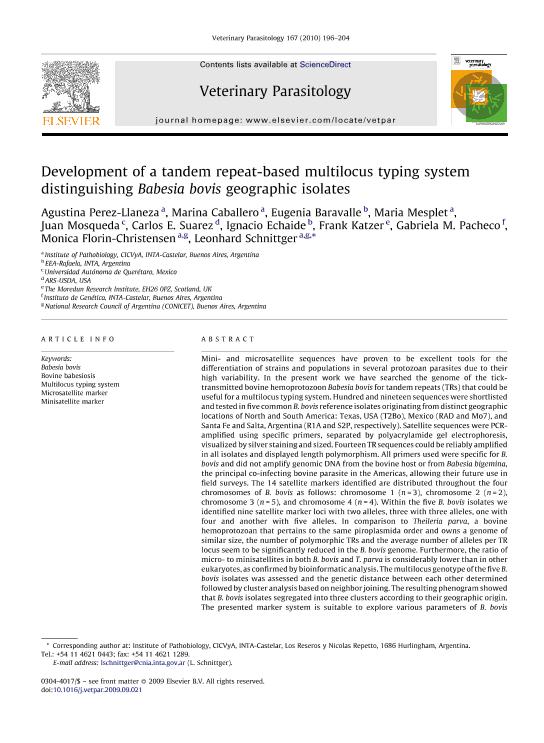Artículo
Development of a tandem repeat-based multilocus typing system distinguishing Babesia bovis geographic isolates
Perez Llaneza, Agustina; Caballero, Marina ; Baravalle, María Eugenia
; Baravalle, María Eugenia ; Mesplet, Maria
; Mesplet, Maria ; Mosqueda, Juan; Suarez, Carlos Esteban; Echaide, Ignacio Eduardo; Katzer, Frank; Pacheco, Maria Gabriela
; Mosqueda, Juan; Suarez, Carlos Esteban; Echaide, Ignacio Eduardo; Katzer, Frank; Pacheco, Maria Gabriela ; Florin Christensen, Mónica; Schnittger, Leonhard
; Florin Christensen, Mónica; Schnittger, Leonhard
 ; Baravalle, María Eugenia
; Baravalle, María Eugenia ; Mesplet, Maria
; Mesplet, Maria ; Mosqueda, Juan; Suarez, Carlos Esteban; Echaide, Ignacio Eduardo; Katzer, Frank; Pacheco, Maria Gabriela
; Mosqueda, Juan; Suarez, Carlos Esteban; Echaide, Ignacio Eduardo; Katzer, Frank; Pacheco, Maria Gabriela ; Florin Christensen, Mónica; Schnittger, Leonhard
; Florin Christensen, Mónica; Schnittger, Leonhard
Fecha de publicación:
09/2009
Editorial:
Elsevier Science
Revista:
Veterinary Parasitology
ISSN:
0304-4017
Idioma:
Inglés
Tipo de recurso:
Artículo publicado
Clasificación temática:
Resumen
Mini- and microsatellite sequences have proven to be excellent tools for the differentiation of strains and populations in several protozoan parasites due to their high variability. In the present work we have searched the genome of the tick-transmitted bovine hemoprotozoon Babesia bovis for tandem repeats (TRs) that could be useful for a multilocus typing system. Hundred and nineteen sequences were shortlisted and tested in five common B. bovis reference isolates originating from distinct geographic locations of North and South America: Texas, USA (T2Bo), Mexico (RAD and Mo7), and Santa Fe and Salta, Argentina (R1A and S2P, respectively). Satellite sequences were PCR-amplified using specific primers, separated by polyacrylamide gel electrophoresis, visualized by silver staining and sized. Fourteen TR sequences could be reliably amplified in all isolates and displayed length polymorphism. All primers used were specific for B. bovis and did not amplify genomic DNA from the bovine host or from Babesia bigemina, the principal co-infecting bovine parasite in the Americas, allowing their future use in field surveys. The 14 satellite markers identified are distributed throughout the four chromosomes of B. bovis as follows: chromosome 1 (n=3), chromosome 2 (n=2), chromosome 3 (n=5), and chromosome 4 (n=4). Within the five B. bovis isolates we identified nine satellite marker loci with two alleles, three with three alleles, one with four and another with five alleles. In comparison to Theileria parva, a bovine hemoprotozoan that pertains to the same piroplasmida order and own a genome of similar size, the number of polymorphic TRs and the average number of alleles per TR locus seem to be significantly reduced in the B. bovis genome. Furthermore, the ratio of micro- to minisatellites in both B. bovis and T. parva is considerably lower than in other eukaryotes, as confirmed by bioinformatic analysis. The multilocus genotype of the five B. bovis isolates was assessed and the genetic distance between each other determined followed by cluster analysis based on neighbor joining. The resulting phenogram showed that B. bovis isolates segregated into three clusters according to their geographic origin. The presented marker system is suitable to explore various parameters of B. bovis populations such as genetic diversity, infection dynamics and their structure under different epidemiological situations, which are of crucial importance for improved control strategies.
Archivos asociados
Licencia
Identificadores
Colecciones
Articulos(CCT - SANTA FE)
Articulos de CTRO.CIENTIFICO TECNOL.CONICET - SANTA FE
Articulos de CTRO.CIENTIFICO TECNOL.CONICET - SANTA FE
Articulos(SEDE CENTRAL)
Articulos de SEDE CENTRAL
Articulos de SEDE CENTRAL
Citación
Perez Llaneza, Agustina; Caballero, Marina; Baravalle, María Eugenia; Mesplet, Maria; Mosqueda, Juan; et al.; Development of a tandem repeat-based multilocus typing system distinguishing Babesia bovis geographic isolates; Elsevier Science; Veterinary Parasitology; 167; 2-4; 9-2009; 196-204
Compartir
Altmétricas



